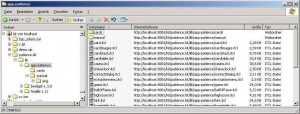This is a simple WebDAV-extension to let TclHttpd work as a WebDAV-server.
News
- August 04 – WebDAV for TclHttpd is program of the week (POTW). Thanks a lot!
- July 04 – Released version 0.1a
Introduction
This is a simple WebDAV-extension which could be used in conjunction with the TclHttpd-Webserver to built a WebDAV-Server.
You have embedded TclHttpd in your application to provide web-access? Why not additionally add WebDAV-support as well?
Because of this being considered as a prototype you should be warned (this is alpha-status).
Features
- WebDAV-Support for files in the webserver-docroot
- WebDAV-Support for vfs-mountable files (such as starkit-, zip- or tar-files)
- Quite easy to extend
- Is tested with:
- Internet Explorer 6.0
- Windows Explorer (on Windows XP)
- DAVExplorer (0.9)
- webdavvfs (the Tcl-WebDAV-client)
So what is that? With the provided tcl-files (see Download) you put into your custom-directory you can turn your TclHttpd-Webserver into a WebDAV-Server. You can e.g. expose vfs-files to be accessed via WebDAV. Suppose you have a zip-file. Put that in your docroot and you can browse through the zip-file with a WebDAV-Client (like Internet Explorer or Konquerer).
Maybe you have some starkits, simply connect a Web folder with your WebDAV-server and browser through the contents of the starkit (see image below).
Though this implementation is quite useful you should be aware of several
Drawbacks
- No support for locking
- No support for authentification
- No support for versioning (so it’s kind of WebDA 😉
- No threading-support (at least: I haven’t tested it)
- Testing is very incomplete (COPY of collections??)
depth-header is mostly ignored- many empty spaces in the implementation
Keep in mind, that this was just a fun-project for me and no serious WebDAV-implementation. One more drawback is the mapping of path-prefixes to the Url-Prefix-Handler. Maybe I will change that later.
Preconditions
WebDAV for TclHttpd needs the following modules:
- TclHttpd (Version 3.5.1)
tdom(for XML-Support)tcllib1.6 (forstruct-,uri– andfileutil-packages)
If you get the latest Tcl-Distribution everything should be in place (besides TclHttpd).
Installation
To make your TclHttpd WebDAV-aware simply follow these steps:
- Download webdav_01a.zip
- Extract the zip-file into the ‚custom‘-directory of your TclHttpd-installation
- Create a directory in the ‚htdocs‘-directory that should provide WebDAV-access (e.g.
dav) - put some files in that directory
- Create another directory (let’s say
kit) in which you may place starkit-, zip- or tar-files (be sure to use the extensions.kit,.taror.zipresp. in all other cases the files will not be recognized (seewebdav_vfs.tcl). - Adapt
webdav.confto your needs (if you follow this example and use the given directory-names, everything should work with the providedwebdav.conf
That’s it.
Now you can use your Internet Explorer and create/open a Web folder with this Url:
http://your-server:your-port/kit/(or/dav/)
If you have a standard installation of TclHttpd use: http://localhost:8015/dav/
Remember to check „Open as webfolder“.
Depending on the content in that directory you could see something like this:
This image shows a mapped Web folder in the usual Windows-Explorer. Currently I just browsed inside the
file-structure of patience.kit (an implementation of the patience-card-game which I just had lying around, you can download the starkit from [1]).
Configuration
To configure WebDAV have a look at webdav.conf. The content is explained a little bit more detailled in the next chapter.
Extend WebDAV
Maybe you even want to extend WebDAV for other purposes. Simply create a file like webdav_mymodule.tcl inside the TclHttpd-custom-directory. Add the following lines to webdav.conf.
webdav_resource ''/your-path'' {
filename custom/webdav_mymodule.tcl
namespace my::webdav::module
}
When TclHttpd starts it reads the custom-directory-files. Sourcing webdav.tcl results in evaluating webdav.conf. All resources listed there would be read in as well.
The function webdav_resource takes 2 parameters. The first one is the absolute path in your htdocs (this is used to install the handler with Url_PrefixInstall) The second parameter contains a list of key-value-pairs. filename and namespace must be given to let webdav automatically source in the files and call the corresponding functions. More key-value-pairs can be entered and could be used by your own module.
Your module has to support a few functions (to get a working WebDAV-functionality). These are:
- your_namespace
::GET - your_namespace
::PROPFIND
Furthermore you can implement all functions which are needed by WebDAV according to rfc2518.
Download
Examples
You want to give it a try but don’t have a WebDAV-client? Why not use webdav_vfs from tclvfs?
Assume you have put a starkit.kit inside htdocs/kit. Open a tcl-shell and then mount the resource (in this example an url to the webdav_vfs-handler):
package require vfs vfs::webdav::Mount http://localhost:8015/kit/ kit cd kit glob * ;# yields a list of file-names in the kit-directory # assume you have a starkit there (e.g. patience.kit, see image above) cd patience.kit # you're now inside the starkit-file glob * ;# return a list of files/directories inside the starkit
You can do so with zip- or tar-files as well. Isn’t that crazy? You access
zip-files via WebDAV. I’m quite astonished about this 🙂 and I’m having a lot of fun with it.
Be warned. The webdav-client implementation needs at least as much work as this webdav-server implementation 🙂
History
29. Jul. 2004
Released version 0.1a (damn IE is such a nit-pick DAV-client). Removed property lastaccessed!
28. Jul. 2004
Released initial version (0.1)
References
Copyright/License
This software is copyright © 2004-2010 by Stefan Vogel.
This software is released under GPL.

Feine Arbeit! Ich werde es mir mal angucken. Wenn Zeit erlaubt, schaue ich
dass ich es evtl. fuer AOLserver anpasse.
Gruesse, Zoran
Im Zuge der Migration auf WordPress habe ich alle „kastrierten“ SPAM-Kommentare gelöscht. Eigentlich schade, denn es waren so aussagekräftige dabei wie:
Good site!!! I found your site in the google. (sehr geistreich)
Sentimental and nostalgic. Great. (wie bitte?)
I wanted to thank you for the time you spent building this page (na, das passt immer)
I you all love! (Hallo?)